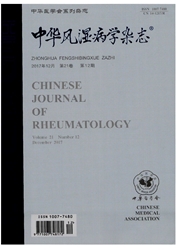

 中文摘要:
中文摘要:
目的了解SS患者唇腺组织及外周血淋巴细胞中核因子-KB激活剂1(Act1)的表达情况,探索其可能的调节机制。方法收集10例SS患者及5例非SS患者的唇腺组织,通过免疫组织化学方法了解Act1在唇腺组织的表达,免疫荧光双染对Act1阳性细胞进行定位。收集28例SS患者及22名健康对照者的PBMCs,应用RT—PCR方法测定PBMCs中Act1-mRNA的表达量,应用流式细胞术检测淋巴细胞亚群中Act1的表达情况。采用Wilcoxon检验和Mann—whitneyU检验及Pearson相关分析进行统计学分析。结果SS患者唇腺组织中可见大量Act1阳性细胞,明显高于非SS患者,而非SS患者唇腺组织中仅偶有Aetl阳性表达;通过免疫荧光双染发现Actl阳性细胞以CD4+T细胞为主,B细胞鲜见Actl表达。外周血CD4+T细胞、CD8+T细胞以及CD20+B细胞中Act|表达的平均荧光强度均略高于健康对照组,但差异均无统计学意义。SS组患者PBMCs中Actl-mRNA水平高于健康对照组(分别为0.84±0.35和0.79±0.21,U=274.5,P〉0.05);伴IgG升高的SS患者Act1—mRNA表达水平高于IgG正常SS患者(分别为0.88±0.39和0.75±0.27,U=73.0,P〉0.05),存在内脏器官受累的SS患者Act1表达水平高于无内脏受累的SS患者(分别为0.92±0.38和0.77±0.33,U=75.0,P〉0.05),但差异均无统计学意义。结论SS患者唇腺组织T细胞中高表达Act1,但B细胞表达Act1受抑制,外周血T、B淋巴细胞中Actl表达略高于健康对照者,推测Act!可能分别通过正反馈和负反馈机制调节IL-17介导的T细胞免疫以及B细胞介导的免疫反应参与SS的发病。Actl很可能参与SS发病,可能与SS疾病活动性和严重性有关。
 英文摘要:
英文摘要:
Objective To explore the nuclear factor-kappa-B activator 1 (Actl) expression in salivary gland and peripheral blood lymphocytes in patients ,with Sj6gren's syndrome (SS), and to explore its possible regulatory mechanisms. Methods The Act1 expression in salivary gland tissue from l0 patients with SS was analYzed by immunohistochemical staining, and immunofluorescence double staining was used to detect Actl-expressing cells. Peripheral blood mononnclear cells were obtained from 28 SS patients and 22 healthy controls (HC). The Actl expression in different lymphocyte subpopulations was determined by flow cytometry and Actl-mRNA expression was detected by reverse transcription polymerase chain reaction (RT-PCR), and the data was analyzed by Wilcoxon test and Mann-Whitney U test and Pearson correlation analysis. Results Remarkable expression of Act1 in the salivary glands from SS patients was observed, especially in T lymphocytes, in contrast to the few expression in B lymphocytes. The expression of Actl in the peripheral CD4+ T cells, CD8+ T cells, CD20+ B cells was higher in SS patients than HC. There was no significant difference of Actl-mRNA levels in peripheral blood mononuclear ceils in healthy controls and SS patients. However, a tendency of up-regulation of Actl expression was noticed in SS patients than healthy controls (0.84±0.35 vs 0.79±0.21, U=274.5, P〉0.05), and the up-regulation of Actl was also found in those SS patients with hypergammaglobulinemia (0.88±0.39 vs 0.75±0.27, U=73.0, P〉0.05) or with internal organ involvement(0.92±0.38 vs 0.77±0.33, U=75.0, P〉0.05), but the differences were not statistically significant.
 同期刊论文项目
同期刊论文项目
 同项目期刊论文
同项目期刊论文
 期刊信息
期刊信息
